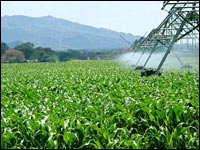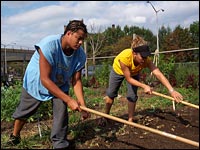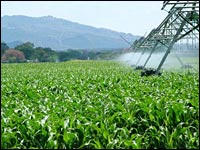If you’re going to talk about poverty, food, and the environment in the United States, you might as well start in the Corn Belt.

So good, and so good for you — until it’s turned into soda.
Photo: stock.xchng.
This fertile area produces most of the country’s annual corn harvest of more than 10 billion bushels, far and away the world’s largest such haul. Where does it all go? The majority — after accounting for exports (nearly 20 percent), ethanol (about 10 percent, and climbing), and excess (another 10 percent) — anchors the world’s cheapest food supply in purchasing-power terms.
Our food system is shot through with corn. It feeds the animals that feed us: more than 50 percent of the harvest goes into domestic animal operations. About 5 percent flows into high-fructose corn syrup, adding a sweet jolt to soft drinks, confections, and breakfast cereal. All told, it’s a cheap source of calories and taste. Yet all this convenience comes with a price — and not just an environmental one.
According to the U.S. Department of Agriculture, the amount Americans spend on food as a percentage of disposable income has fallen from 15.4 percent in 1980 to 10.8 percent in 2004. But while we’ve spent less money on food, our waistlines have expanded. The obesity rate, after hovering around 15 percent from 1960 to 1980, surged to 31 percent in the last 25 years, USDA figures show. The percentage of overweight children tripled in the same time period. Meanwhile, incidence of type II diabetes, a diet-related condition with a host of health-related complications, leapt 41 percent from 1997 to 2004.
Related Stories
Turn the Eat Around Forgotten by many, a Brooklyn neighborhood nourishes its ownAttack of the killer corn Why the heavily subsidized corn harvest amounts to an annual environmental calamity.
This trend has hit low-income groups particularly hard. The obesity rates for “poor” and “near-poor” people stand at 36 percent and 35.4 percent, respectively, against an overall average of 29.2 percent for “non-poor,” the Centers for Disease Control and Prevention reports. While the CDC doesn’t break down diabetes rates by income, a look at the disease through the lens of ethnicity shows that those rates tend to align with economics: African Americans and Mexican Americans, for instance, have higher diabetes rates than whites, and lower median incomes.
Why do low-income people tend to exhibit more diet-related health problems? Adam Drewnowski, professor of epidemiology at the University of Washington, posits a simple answer: people are gaining weight and getting sick because unhealthy food is cheaper than healthy food — thanks in large part to federal policies.
Sweetness and Power
If the USDA’s food pyramid recommends two to five cups of fruits and vegetables per day, its budget — mandated by Congress through the Farm Bill — encourages different behavior altogether.

Will the real food pyramid please stand up?
Photo: Klaus Post/stock.xchng.
Under the Farm Bill, the great bulk of USDA largesse flows to five crops: corn, soy, cotton, wheat, and rice. Of the $113.6 billion in commodity subsidy payments doled out by the USDA between 1995 and 2004, corn drew $41.8 billion — more than cotton, soy, and rice combined. By contrast, apples and sugar beets, the only other fruit or vegetable crops that draw federal subsidies, received $611 million over the same period. (The latter are generally processed into sweeteners.)
The huge corn payouts encourage overproduction, and have helped sustain a long-term trend in falling prices. According to figures from the U.N.’s Food and Agriculture Organization, the inflation-adjusted global commodity price for corn plunged 61 percent between 1983 and 2002. Today a bushel, roughly 56 pounds, fetches about $2.
Cheap corn, underwritten by the subsidy program, has changed the diet of every American. It has allowed a few corporations — including Archer Daniels Midland, the world’s largest grain processor — to create a booming market for high-fructose corn syrup. HFCS now accounts for nearly half of the caloric sweeteners added to processed food, and is the sole caloric sweetener for mass-market soft drinks. Between 1975 and 1997, per-capita consumption jumped from virtually nothing to 60.4 pounds per year — equal to about 200 calories per person, per day. Consumption has generally hovered around that level since.
According to Drewnowski and his student Pablo Monsivais, cheap and abundant additives such as HFCS allow manufacturers to sweeten food liberally without adding much to their production costs. For people on a tight budget, these additives can also make cheap food the most efficient way to get calories.
To illustrate his point, Drewnowski distinguishes between “energy-dense” and “nutrient-dense” foods. For energy-dense, think of a package of Ding Dongs — 360 calories, 19 grams of fat, and a liberal dose of high-fructose corn syrup. For nutrient-dense, think of a three-ounce chunk of wild salmon, delivering high-quality protein and essential fatty acids, among other nutrients, in a 185-calorie package. The former will run you about a buck at any convenience store, bodega, or supermarket in the country. For the latter, prepare to sidle up to a pristine Whole Foods fish counter and shell out about $5.
From a short-term economic viewpoint, the Ding Dongs present a better deal: 360 calories per dollar, and no need for the time or skill to cook. “If you’re on a limited income trying to feed a family, in a sense you’re behaving rationally by choosing heavily sweetened and fat-laden foods,” Drewnowski says.
The price gap between these two categories is growing. Drewnowski and Monsivais show that the overall cost of food consumed at home, when adjusted for inflation, has been essentially unchanged since 1980. But over the same time, the price of soft drinks plunged 30 percent, and the price of candy and other sweets fell 20 percent. Meanwhile, the price of fresh fruits and vegetables rose 50 percent.
“Energy-dense foods … are the cheapest option for the consumer,” Drewnowski says. “As long as the healthier lean meats, fish, and fresh produce are more expensive, obesity will continue to be a problem for the working poor.”
Thus far, government efforts to address diet-related health problems among low-income Americans have done little to reduce incidence of obesity and diabetes. One reason may be that even when they do account for the economics of different types of foods, such programs often neglect other pressures faced by low-income families.
In 1999, for example, the USDA began promoting a revised “Thrifty Food Plan,” designed to help people choose low-cost, healthy foods. But as Diego Rose of Tulane University’s Department of Community Health Sciences showed in a 2004 study, the plan failed to account for time stresses on working-class families. Rose calculated that it would take an average of 16 hours per week to prepare the meals outlined in the Thrifty plan, and that working women tended to have only about six hours per week to devote to the kitchen at the time the plan was unveiled.
Changing Diets, and Lives
Grassroots, community-driven efforts may prove more effective in transforming diets than any federal policy. The Los Angeles-based Community Food Security Coalition represents 325 organizations in the U.S. and Canada dedicated to “building strong, sustainable local and regional food systems that ensure access to affordable, nutritious, and culturally appropriate food to all people at all times.”

Tending a community garden in Brooklyn, N.Y.
Courtesy of Added Value.
Unlike the USDA and other pieces of the federal bureaucracy, groups like CFSC tend to view food as part of a broader economic-development effort. “Not only are people in low-income communities getting sick from the food they have access to, but the economies are sick, too,” says Hank Herrera, a pioneer in the community food-security movement who has served on CFSC’s board. Herrera runs the Rochester, N.Y.-based Center for Popular Research, Education, and Policy and the New York Sustainable Agriculture Working Group. “You can’t separate community-level economics from food advocacy.”
Herrera became active in food politics in 1993, after the only supermarket in his northeast Rochester neighborhood burned down. Median household income in the neighborhood hovered below the poverty line; its economic profile resembled that of the South Bronx. The chain that owned the store opted not to rebuild, and residents faced two options familiar to people in poor neighborhoods all over the country: travel to a wealthier neighborhood to buy food, or shop at corner stores, where the prices are high and fresh food is scarce.
Herrera helped found North East Neighborhood Alliance. Although the group put the numbers together to convince the Dutch multinational supermarket chain Tops to open an outlet in the area, residents weren’t satisfied. “We realized it was great to have a supermarket in the area. But the profits leave the neighborhood, and local farmers and producers are ignored,” Herrera says. So NENA kept organizing. Today, the group oversees a 2.7-acre tract that houses a working organic farm and a restaurant. “There was a pent-up demand for consistent access to fresh fruits and vegetables, and we delivered it,” Herrera says. “And we created not only jobs, but capital formation. The profits stay here.”
Ken Meter has seen the same dangerous patterns in less populous places. “The situations in rural and urban areas aren’t that much different,” says Meter, of the Minneapolis-based Crossroads Resource Center. “Most farmers in the Midwest are producing for a global commodity market, not for their neighbors or even themselves.” Not only has that model helped lead to rising obesity rates — according to a recent study by the University of Pittsburgh Center for Rural Health Practice, 20 percent of rural seventh-graders qualify as obese, versus 16 percent for their urban peers — it has also been disastrous for local economies.
In one study in southeastern Minnesota, Meter found that between 1997 and 2003, local farmers sold an annual average of $912 million into the global commodity market. But to do so, they spent a jaw-dropping average of $996 million each year — meaning an average annual loss of $84 million. Meanwhile, area residents spent $500 million per year buying food from outside the region, and another $500 million purchasing farm fertilizer and other inputs produced outside the region. Combined, that makes an outflow of $1 billion — or more than the area brings in by selling into the commodity market.
“Essentially, this economy is extractive,” Meter says. “Our food system doesn’t build wealth in our high-producing areas, it extracts wealth.” Meter says the area’s economy benefits not local farmers or consumers, but rather the large operations like Archer Daniels Midland and Cargill, which thrive on low prices for commodity inputs. The federal government picks up the tab for a failing economy; between 1997 and 2003, federal subsidies poured into southeastern Minnesota an average of $98 million per year.
Meter reckons that if the region’s consumers were to buy 15 percent of their food from local sources, it would generate as much income for the region as two-thirds of farm subsidies. He says the Southeast Minnesota Food Network, an organization formed in 2001 to refocus area farmers on producing for the local market and encourage consumers to buy local, has been using his data to recruit new members.
As the federal government dithers with its food pyramids and ruinous cheap-corn policy, low-income communities are organizing to gain control over the quality of their food supply. Meter’s work in the Midwest and Herrera’s in the Northeast represent the rumblings of a growing real-food underground — an upsurge that challenges not just the hegemony of processed food, but also the social relations that allow it to thrive.
Click here to read about a community food uprising in Brooklyn, N.Y.



